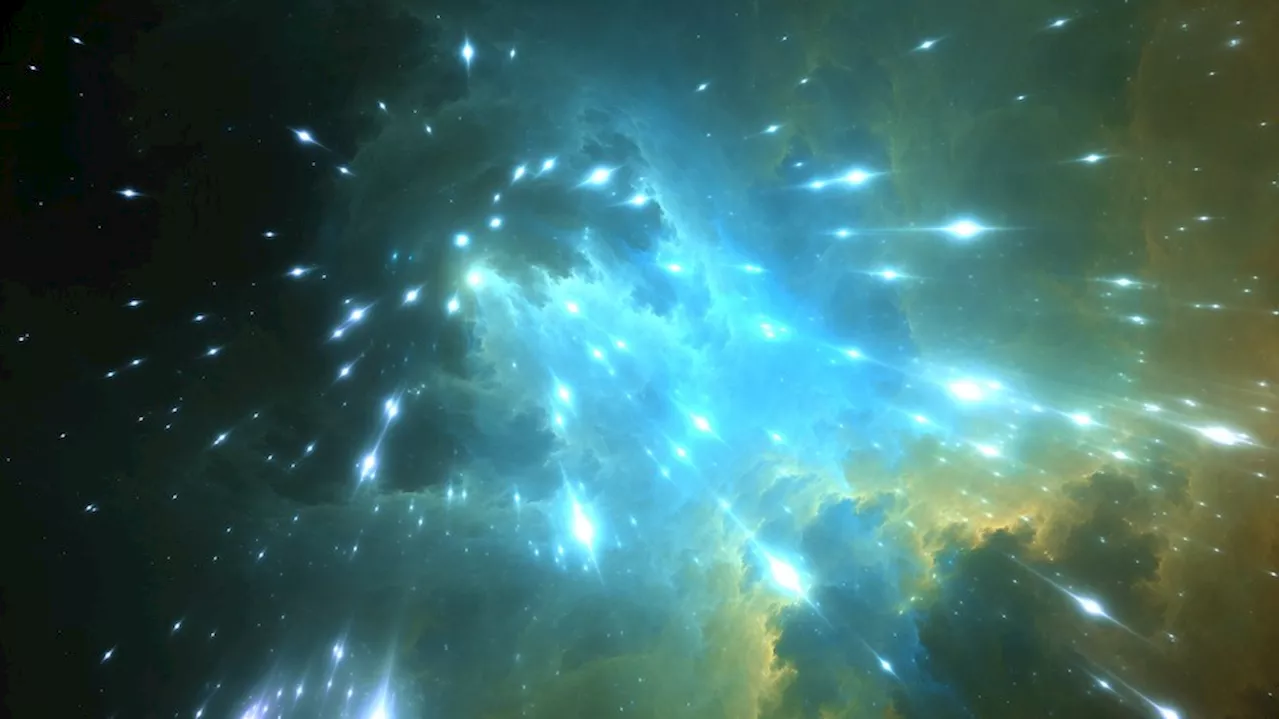Astronomers have discovered three ultra-faint dwarf galaxies in a pristine, isolated environment, devoid of gas and populated solely by ancient stars. This finding supports theories that star formation in these tiny galaxies was abruptly halted in the early Universe, possibly due to the Epoch of Reionization or early supernova explosions.
Astronomers have made a groundbreaking discovery by studying three ultra-faint dwarf galaxies located in a remote region of space, far from the gravitational influence of larger structures like the Milky Way. Utilizing data from both the DESI Legacy Imaging Surveys and the Gemini South telescope, researchers found that these galaxies consist solely of very old stars, lending credence to the theory that events in the early Universe prematurely halted star formation in the smallest galaxies.
Ultra-faint dwarf galaxies, the faintest type in the Universe, typically contain only a few hundred to a thousand stars, a stark contrast to the hundreds of billions found in our Milky Way. Due to their faintness, astronomers have primarily discovered them near our own galaxy, but this proximity presents a challenge as the Milky Way's gravitational forces and hot corona can strip away the dwarf galaxies' gas, disrupting their natural evolution. Furthermore, beyond the Milky Way's sphere of influence, these ultra-faint galaxies become increasingly diffuse and difficult to detect with traditional methods.This is where the meticulous work of University of Arizona astronomer David Sand comes into play. Sand employed a manual, by-eye search technique to identify three faint and ultra-faint dwarf galaxies in the direction of spiral galaxy NGC 300 and the Sculptor constellation. He focused on areas of the sky that had not been thoroughly explored before, leading to the discovery of these unique objects. The images captured by Sand were taken as part of the DECam Legacy Survey (DECaLS), one of three public surveys known as the DESI Legacy Imaging Surveys. These surveys jointly imaged 14,000 square degrees of sky to identify potential targets for the ongoing Dark Energy Spectroscopic Instrument (DESI) Survey. DECaLS utilized the 570-megapixel Dark Energy Camera (DECam), mounted on the U.S. National Science Foundation's Víctor M. Blanco 4-meter Telescope at Cerro Tololo Inter-American Observatory (CTIO) in Chile. To delve deeper into these galaxies, Sand and his team employed the Gemini South telescope, part of the International Gemini Observatory, partially funded by the NSF and operated by NSF NOIRLab. The Gemini Multi-Object Spectrograph (GMOS) captured stunningly detailed images of all three galaxies, revealing that they appear devoid of gas and composed entirely of very old stars. This finding supports existing theories that ultra-faint dwarf galaxies are essentially 'ghost towns' where star formation ceased early in the Universe.The lack of gas in these galaxies, crucial for the formation of new stars, is attributed to their small size and weak gravitational pull. This makes them susceptible to losing gas when disturbed by other cosmic events. However, the Sculptor galaxies are located far from any significant galactic neighbors, ruling out the possibility of gas being stripped away by these larger structures. Therefore, astronomers propose alternative explanations for the absence of gas. One possibility is the Epoch of Reionization, a period shortly after the Big Bang when high-energy ultraviolet photons permeated the cosmos, potentially stripping gas from the smallest galaxies. Another explanation is that the earliest stars in these dwarf galaxies underwent massive supernova explosions, ejecting gas at incredibly high speeds, thereby expelling the gas from their own hosts. If reionization is responsible for the gas depletion, these galaxies could provide invaluable insights into the very early Universe. Studying these 'fossil galaxies' could reveal whether reionization occurred uniformly or in a patchy, localized manner. More observations of these and other ultra-faint dwarf galaxies are needed to confirm these theories and further unravel the mysteries surrounding the formation and evolution of the smallest galaxies in the Universe
Ultra-Faint Dwarf Galaxies Star Formation Reionization Epoch Of Reionization Supernovae DESI Legacy Imaging Surveys Gemini South Telescope Astronomy
United States Latest News, United States Headlines
Similar News:You can also read news stories similar to this one that we have collected from other news sources.
 Ghost ships to ghost sharks: 10 wildest underwater discoveries of 2024Andrew Paul is Popular Science's staff writer primarily focused on tech news. Previously, he was a regular contributor to The A.V. Club and Input, and has had recent work featured by Rolling Stone, Fangoria, GQ, Slate, NBC, as well as McSweeney's Internet Tendency. He lives outside Indianapolis.
Ghost ships to ghost sharks: 10 wildest underwater discoveries of 2024Andrew Paul is Popular Science's staff writer primarily focused on tech news. Previously, he was a regular contributor to The A.V. Club and Input, and has had recent work featured by Rolling Stone, Fangoria, GQ, Slate, NBC, as well as McSweeney's Internet Tendency. He lives outside Indianapolis.
Read more »
 Blue Ghost Lunar Lander to Explore Mare Crisium in 'Ghost Riders in the Sky' MissionThe Blue Ghost lunar lander is set to launch on the 'Ghost Riders in the Sky' mission from NASA's Kennedy Space Center. After orbiting Earth for 25 days, it will fly to the moon, spending 16 days in lunar orbit before attempting an autonomous landing in Mare Crisium. The mission aims to capture high-definition images of the lunar surface and study the moon's magnetosphere.
Blue Ghost Lunar Lander to Explore Mare Crisium in 'Ghost Riders in the Sky' MissionThe Blue Ghost lunar lander is set to launch on the 'Ghost Riders in the Sky' mission from NASA's Kennedy Space Center. After orbiting Earth for 25 days, it will fly to the moon, spending 16 days in lunar orbit before attempting an autonomous landing in Mare Crisium. The mission aims to capture high-definition images of the lunar surface and study the moon's magnetosphere.
Read more »
 Ultra-High-Energy Cosmic Rays: Probing the Universe's Most Energetic EventsSpace, while seemingly empty, is traversed by ultra-high-energy cosmic rays, containing millions of times more energy than the Large Hadron Collider. These rays, thought to originate from the most energetic events in the universe like supernovae and active galactic nuclei, may be linked to magnetic turbulence. Studying these particles, which bombard Earth and produce secondary particles, helps scientists understand their origins and potential impact on Earth's climate and biodiversity.
Ultra-High-Energy Cosmic Rays: Probing the Universe's Most Energetic EventsSpace, while seemingly empty, is traversed by ultra-high-energy cosmic rays, containing millions of times more energy than the Large Hadron Collider. These rays, thought to originate from the most energetic events in the universe like supernovae and active galactic nuclei, may be linked to magnetic turbulence. Studying these particles, which bombard Earth and produce secondary particles, helps scientists understand their origins and potential impact on Earth's climate and biodiversity.
Read more »
 Samsung Galaxy S25 Ultra Camera Leak: Incremental Upgrades, But A Big Ultra-Wide ChangeLeaked sensor details for the Samsung Galaxy S25 Ultra suggest incremental camera upgrades compared to its predecessor, but a notable upgrade to the ultra-wide sensor.
Samsung Galaxy S25 Ultra Camera Leak: Incremental Upgrades, But A Big Ultra-Wide ChangeLeaked sensor details for the Samsung Galaxy S25 Ultra suggest incremental camera upgrades compared to its predecessor, but a notable upgrade to the ultra-wide sensor.
Read more »
 Nubia Z70 Ultra vs. Galaxy S24 Ultra: A Camera and Performance ShowdownThis article compares the Nubia Z70 Ultra and the Galaxy S24 Ultra, highlighting the Nubia's advantages in camera technology, performance, and battery life.
Nubia Z70 Ultra vs. Galaxy S24 Ultra: A Camera and Performance ShowdownThis article compares the Nubia Z70 Ultra and the Galaxy S24 Ultra, highlighting the Nubia's advantages in camera technology, performance, and battery life.
Read more »
 Nubia Z70 Ultra: A Camera-Centric Beast that Takes on the Galaxy S24 UltraThe Nubia Z70 Ultra boasts a groundbreaking under-screen selfie camera and the powerful Snapdragon 8 Elite Gen 2 processor, challenging the Galaxy S24 Ultra in key areas. The article compares the two flagships, highlighting the Nubia's superior performance and battery life.
Nubia Z70 Ultra: A Camera-Centric Beast that Takes on the Galaxy S24 UltraThe Nubia Z70 Ultra boasts a groundbreaking under-screen selfie camera and the powerful Snapdragon 8 Elite Gen 2 processor, challenging the Galaxy S24 Ultra in key areas. The article compares the two flagships, highlighting the Nubia's superior performance and battery life.
Read more »
